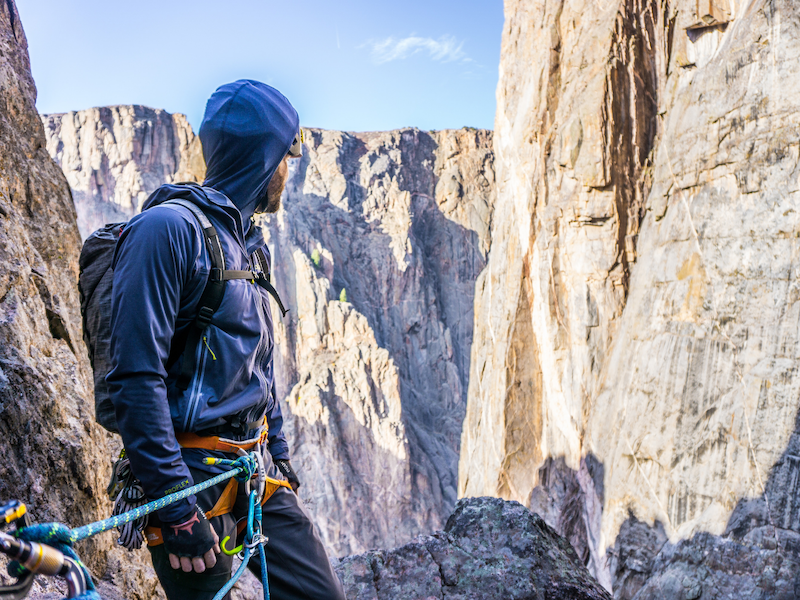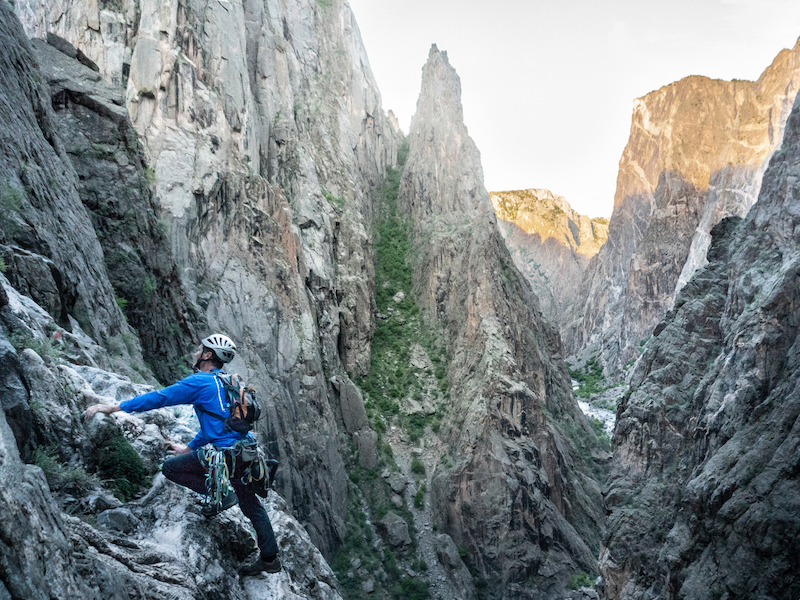“Down and Up” Packing Tutorial
Multi-pitch routes traditionally are approached from below with the technical climbing beginning and ending in more or less the same place thus allowing parties to stash gear at the base while on route. It’s convenient to hike in with a larger more comfortable pack containing extra water, extra layers, and so on to have a mini base camp at the start of the route. However, routes where the descent takes a different path necessitate an “up and over” kit.
In the Black Canyon this norm of approaching from below is literally flipped on its head. The approach starts on the rim on the canyon, often in the dark, and ends at the bottom of the canyon before getting on route and climbing back to the rim. We’ll call this page the Black Canyon “down and up” packing page and dive into the various strategies for climbing with the kit you need to get to the base on your back or on your harness.
Choosing a Pack / No Pack
There are two schools of thought here. Many climbers eschew the bulk of a pack for the minimalist strategy of clipping approach shoes and a water bottle to their harness. You’ll see your guide (and a lot of others) climbing with a small “bullet” pack in the range of 15 to 30 liters. For us leading a party on a longer route, the ability to take extra water, a first aid kit, and have everything stowed away is a priority. It’s also partly a function of the fact guides are used to climbing with a pack. Our pick for an on route pack is the Petzl Bug (18 liters). The Black Diamond Bullet (16 liters) is also a great choice and certainly the time tested (and namesake) on route rock climbing pack. Peak provides on route packs for guests if you don’t have your own.
Technical Equipment
Here is a basic list of the technical equipment a FOLLOWER would want for a day in the Black Canyon. This equipment is included on a guided day in the Black with Peak if you don’t have your own:
– Helmet (UIAA approved)
– Climbing harness (must have a belay loop)
– Belay device w/ dedicated pear shaped locking carabiner
– Nylon 120cm sling w/ locking carabiner
– One large pear shaped locking carabiner to clove to the anchor with (Petzl William or Attache)
– Optional: chalk bag
– Optional: belay gloves
What would the gear list for a leader be? It depends. Feel free to contact us to ask general questions about a leader’s kit but be advised, you’ll get a lot of “it depends” on your movement skill, risk tolerance, and general preferences.
Footwear
Rock climbing shoes: Comfort is key and there is no one climbing shoe that is best for every application. The La Sportiva TC Pro is by in large one of the best climbing shoes ever conceived. Sized to wear with thin socks this gets pretty darn close to a quiver of one – at least for all day climbs.
Approach shoes: Many of the canyon descents (if not all of them) require technical scrambling and/or rappels. Footwear you can confidently move through 3rd and 4th class terrain is essential. Ideally, the shoe you bring to the Black is on the lighter weight end of the spectrum since you will need to carry it on your back. Check out the Arc’teryx Acrux.
Food / Water
Sandwich or other solid food for lunch that isn’t 100% sugar combined with candy bars, Clif bars, Gu, or fancy organic blocks of dried ambivalence will get you through. Minimum of 1 liter of water and maybe up to 3 liters if the temps are higher (~70 degF or above and you’re in the sun). The Platypus collapsible bottle is the guides’ pick. Rigid Nalgene bottles are difficult to cram into a 16-18 liter pack with shoes, kit, and everything else.
Miscellaneous
Sunscreen and lip balm
Sunglasses (with hard case)
Wag Bag w/ extra wet wipes
Camera (cell phones get the job done)
First aid kit (the guide will have one but extra climbing tape, Ibuprofen, or basics can be a good addition)
Putting It All Together
Carrying the Rope
The optimal choice of rope coil depends on what type of pack you have (or don’t have). If you don’t have a pack a “backpack coil” is a great option. A pack that supports the weight of a rope like the Petzl Bug carries a “butterfly coil” well. On the smaller end of the range with packs that don’t support extra weight a “mountaineers coil” is a good way to carry a rope; just make sure you know how not to turn your rope into a hopeless wad of twists…
How to video: Butterfly Coil
How to video: Backpack Coil
How to video: Mountaineers Coil (This is a treat!)
Rack up at the Car
If your pack is big enough to accommodate a harness complete with kit you’ll have the luxury of a more comfortable descent. However, it probably means you could wear your harness from the car, downsize the pack, and climb with less bulk. Go with the smallest possible pack and wear the harness all day. There is balance to be had. Putting larger cams and extendable quickdraws in the pack makes scrambling less cumbersome and snags on trees less likely. Pick one. Climb. Refine.
Best place to carry a helmet? On your head. You’ll want to put it to use usually no less than 5 minutes from the car so why try to find a way to pack it.
Contact Us
Mountain Trip
135 W Colorado Ave 2A | Telluride, C0 81435


